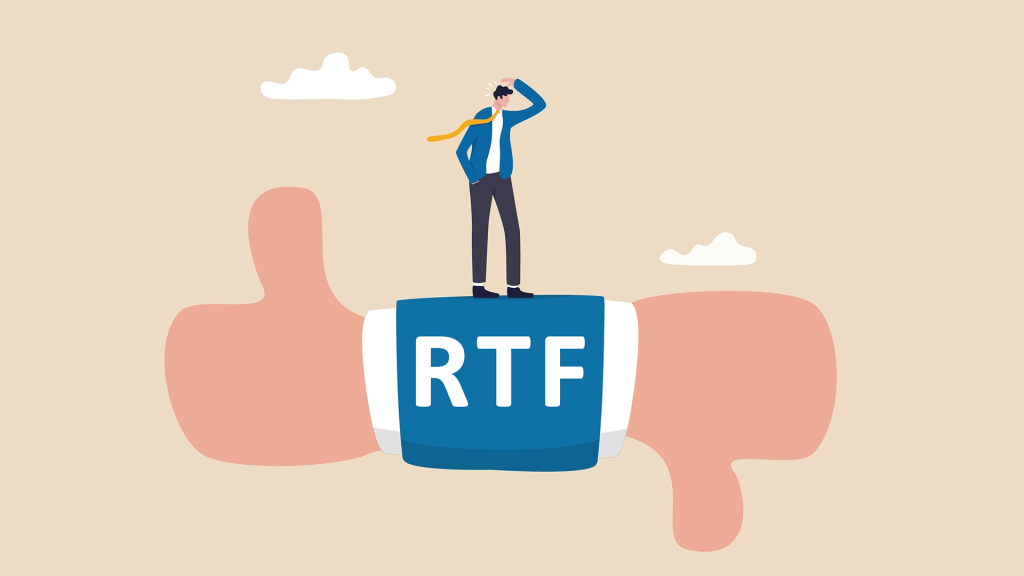

17 feb 2025
RTF stands for Rich Text Format, but it probably doesn’t reveal the main intrigue of the article’s title. As the name of the format implies, its intended use is to support text content in its various forms—or, at least, was. See, the main concern with RTF is that it’s a pretty much legacy format, even though it continues to exist in the vastness of the global document flow. Its official support ended almost two decades ago—in 2008 when Microsoft released the last revision of RTF. However, you can still regularly come across those Rich Text files, especially on Apple products. So, what’s the deal with RTF, and why not have exclusively DOC files? This question, as well as many others you may have, will be thoroughly answered in the article below.

RTF was originally developed by Microsoft in 1987 as a cross-platform text format that supported documents on both Macintosh and Windows systems between the corresponding versions of Microsoft Word applications. Basically, the main premise was to establish a seamless text-editing experience between the two rival ecosystems and benefit Microsoft products regardless of the platform used to view RTF files. The idea persisted, and it took Microsoft more than 20 years to finally abandon RTF and completely switch to XML-based formats.
The cross-platform compatibility and universality of RTF were bolstered with all Microsoft online help files and manuals initially shipped as RTF files. Over the years, RTF has undergone multiple functionality updates, evolving through many iterations, which kept it somewhat on par with other, more sophisticated text formats that were constantly emerging—until the advent of XML mentioned above. But while discovering the history of the RTF format might be engaging for some, most of you are probably here to learn how to handle it.
In most cases, RTF doesn’t need any special treatment. You can easily open, view, and edit it on both Windows and macOS, so it shouldn’t be a concern for desktop users. However, in our modern era, when efficiency and compatibility are of the utmost importance, it’s often a better option to convert an RTF file to a more universally accepted format—like PDF. iScanner’s web converters are designed exactly for that purpose, and the mobile app offers the same converting feature.

The key advantage of Rich Text is its simplicity in terms of both user interaction and under-the-hood functionality. In a scenario when you only need so much text formatting and have to produce a text file quickly, RTF is a natural lifesaver. It offers the most basic features, such as font style, type, and size, as well as document margins for printing and left, right, or centered text alignment. Depending on the exact RTF revision, it may even support images.
What makes RTF functionally simple is its encoding. The most basic text editor can open and view the contents of an RTF file even if such compatibility isn’t explicitly stated in the application’s list of features. This phenomenon is known as interoperability. Obviously, some formatting may and will be lost upon re-saving, especially any pasted images, but if the main goal is to preserve text information with the simplest formatting, RTF is the way to go. With modern XML-based formats, you can’t do that, as those simple text editors won’t even recognize the contents of such complex files, making RTF a viable option even in 2025.
The impressive human and machine readability of RTF makes it quite versatile. However, speaking of the flaws of Rich Text, the main disadvantage is its inability to handle large files. If it’s plain text, you can still wiggle around and probably open, save, and share such files without any serious issues. But if you add a lot of formatting, even as simple as choosing font styles, RTF can become unbearable.

Comparing RTF to DOC (or its modern iteration DOCX) isn’t strictly about determining which format is ultimately better since each serves a different purpose. It’s best to view this comparison as the contrast between simplicity and complexity. As mentioned above, if you’re about to craft some plain text without masterful formatting, Rich Text is the way to go. It isn’t as straightforward and featureless as TXT, but it doesn’t go beyond some basic formatting either. DOC and DOCX files, on the other hand, allow for more sophisticated stylization of written text, meaning you probably won’t be able to view them with default pre-installed applications.
This opposition of simplicity and complexity extends further. Since complex formatting isn’t supported by Rich Text, files saved in this format tend to be more lightweight than DOC or DOCX. The latter can be extremely demanding in terms of storage, so the decision of which format to choose should be approached thoughtfully. Another key difference between the formats is that RTF is free to use, so nothing holds you back from creating an application designed for this format. DOCX, on the other hand, belongs to Microsoft, so fiddling around with custom-made DOCX editors and monetizing them may become a legal issue.

So, how did it come down to this weird situation when RTF is considered a legacy format but continues to thrive? Even more impressive is the fact that RTF has already outlived its official support by almost two decades, so there’s no particular reason for it to disappear any time soon. What makes RTF so viable and versatile is the way it stores information. Basically, text and its formatting are saved separately, meaning that virtually any text processing application can view the file’s contents—and in the lucky case it supports additional formatting, it’ll be shown as well.
Some may argue that PDF is far more compatible on modern devices, as there’s always a default application that can open such files on desktop and mobile systems. It’s a statement that is best described by the saying, “Well, yes, but no.” If your only intention is to open and view a PDF file, then the compatibility assumption is true. But if you need to quickly edit text information and apply formatting to it, Rich Text stands tall with its undeniably more impressive approachability.
So, is there any future for RTF? The short answer, considering the format’s history and persistence, is yes. We may see a new solution appear out of nowhere, but there’s probably no need for it since RTF is still widely acceptable. The next time you come across an RTF file and think to yourself, “Why would anyone choose it instead of DOC or PDF,” just remember that it still has its purposes—and you may find it useful, too. But if you ever need to convert an RTF file, you’re very welcome to do so with iScanner.
